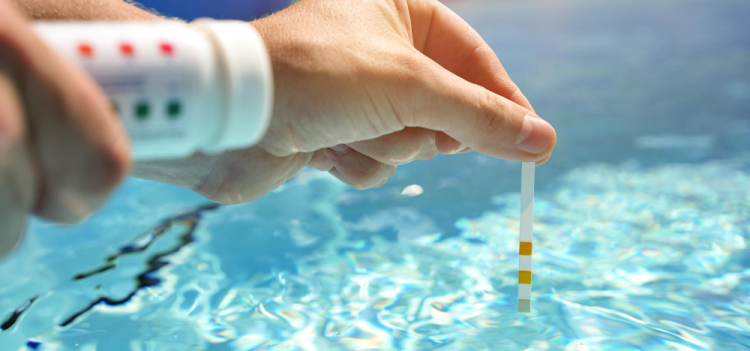Protection of Pool Equipment and Infrastructure
- Preventing Corrosion and Scaling: Imbalanced pH or total alkalinity can lead to corrosion of
metal fixtures, pumps, and filtration systems. If the water is too acidic, it corrodes metal
parts, causing leaks and damage to expensive equipment. High pH, on the other hand, can
cause scaling, which is the buildup of minerals that clogs filters and damages surfaces.
- Reducing Maintenance Costs: Consistent testing helps identify and address issues early,
reducing the need for costly repairs and maintenance. For example, a high level of calcium
hardness can lead to scale buildup on tiles and pool walls, which may require costly acid
washing to remove.
- Extending Equipment Lifespan: Properly balanced water can extend the lifespan of pumps,
filters, heaters, and other pool equipment by preventing the buildup of minerals and
corrosion. Regular testing helps ensure water chemistry remains balanced, protecting
investments in pool infrastructure.
Improving Swimmer Comfort and Experience
- Avoiding Red Eyes and Skin Irritation: When chlorine levels are too high or pH is
imbalanced, swimmers often experience red eyes and irritated skin. Proper testing and
adjustment of chlorine and pH levels can prevent these discomforts, making the swimming
experience more enjoyable.
- Minimizing Strong Chemical Odors: A strong chlorine odour in a pool is often caused by
chloramines, which form when chlorine reacts with sweat, oils, and other contaminants.
Regular testing helps identify and control chloramine levels, which can be reduced by shock
treating the pool and maintaining proper chemical balance.
- Maintaining Clear Water: No one wants to swim in cloudy or murky water, which can be
caused by imbalanced pH, inadequate filtration, or high levels of dissolved organic material.
Regular testing helps keep the water clear and visually appealing by identifying the need for
shock treatment, filtration adjustments, or chemical balancing.
Ensuring Regulatory Compliance
- Following Local Health Department Standards: Many regions have specific guidelines for
public pool water quality, including requirements for disinfectant levels, pH, and cleanliness.
Regular testing ensures compliance with these standards, helping pool operators avoid fines,
legal issues, or forced closures.
- Protecting Public Health: For public and commercial pools, regulatory compliance is not only
about avoiding penalties but also about prioritizing the health and safety of the community.
Pool testing logs provide a record of compliance and show that the pool is being managed
responsibly.
Environmental Impact
- Water Conservation: Regular testing allows for early detection of issues, preventing the need
to drain and refill the pool as often. This conserves water, which is especially important in
areas facing water scarcity.
- Chemical Efficiency: When pool chemicals are properly balanced, fewer chemicals are
needed to maintain water quality. Overuse of chemicals can result in excess runoff that may
impact surrounding vegetation and groundwater. Testing helps minimize the environmental
footprint by ensuring chemicals are used efficiently.
Cost Efficiency
- Avoiding Excess Chemical Use: Testing helps pool owners use only the necessary amount of
chemicals, avoiding the costs associated with over-treatment. If chemicals are used in excess
due to guesswork or incorrect dosing, it can lead to unnecessary expenses.
- Preventing Water Waste: Imbalanced pool chemistry can lead to problems that may require
draining and refilling the pool, which is costly and wasteful. By catching issues early through
regular testing, pool operators can save money on water and chemical costs.
- Detecting Leaks Early: Some test kits allow for the detection of leaks by measuring the loss
of water over time. Catching leaks early can prevent costly repairs and minimize water waste.
Ensuring Proper Sanitization
- Chlorine and Disinfectant Levels: Chlorine and other disinfectants lose effectiveness over
time due to exposure to sunlight, water movement, and contaminants brought in by
swimmers. Regular testing helps maintain the ideal disinfectant level, keeping the water
sanitized and safe.
- Managing Combined Chlorine: Combined chlorine, or chloramines, can build up when
chlorine binds with contaminants in the water. High levels of combined chlorine reduce the
effectiveness of the sanitizing process and contribute to unpleasant odors. Testing for free
chlorine and combined chlorine helps maintain effective sanitization.
Emergency Preparedness
- Quick Response to Contamination: If a swimmer introduces contaminants such as bodily
fluids, testing allows for a rapid response to treat the water and prevent contamination from
spreading. This is especially important in public pools, where many people are at risk if the
water quality declines.
- Preparedness for Algal Blooms: Algae can quickly take over a pool if conditions favor their
growth. By testing regularly for factors such as phosphates and pH, pool owners can prevent
or quickly address algal blooms, which can make the pool unsafe and unsightly.
Key Parameters to Test
Maintaining proper water quality in swimming pools is crucial for ensuring the safety and comfort of
swimmers. Here are some key parameters that are typically monitored:
Ideal range is 7.2 to 7.81. Maintaining the correct pH helps ensure the effectiveness of chlorine and prevents skin and eye irritation.
Essential for disinfecting the water and killing harmful bacteria and viruses1. The recommended level is 1 to 3 parts per million (ppm).
Helps stabilize the pH level. The ideal range is 80 to 120 ppm.
Prevents corrosion and scaling of pool equipment. The recommended range is 200 to 400 ppm.
Acts as a stabilizer for chlorine, protecting it from degradation by sunlight. The ideal range is 30 to 50 ppm.
Measures the clarity of the water. Lower turbidity indicates cleaner water.
Indicates the total concentration of dissolved substances in the water. High TDS can affect water quality and taste.
Regular testing for harmful microorganisms like E. coli and other pathogens to ensure the water is safe for swimming.
Maintaining a comfortable and safe temperature for swimmers, typically between 25°C to 28°C (77°F to 82°F).
Ensuring the water is free from unpleasant odors and tastes, which can indicate contamination.
Regular monitoring and maintenance of these parameters help keep the pool water safe and enjoyab
le for everyone.
